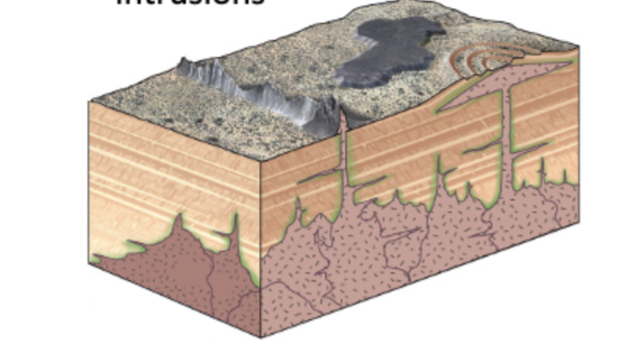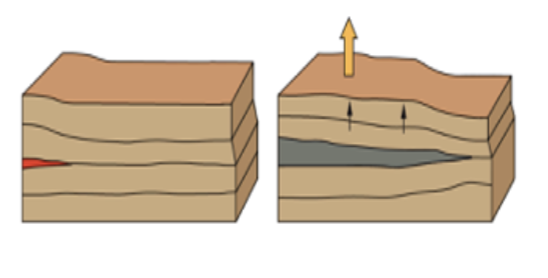UCSB Earth 2 Midterm L 7-8
1/29
There's no tags or description
Looks like no tags are added yet.
Name | Mastery | Learn | Test | Matching | Spaced |
|---|
No study sessions yet.
30 Terms
Volcanic vs. Plutonic rocks
V: molten rocks cooled at or near the surface
P: molten rocks cooled at depth
Geothermal gradient
refers to the fact that as you go deeper into the Earth, the temperatures rise. The gradient refers to have quickly they rise (steep gradient = temp rises quickly.
solidus vs. liquidus
S: conditions at which rocks start to melt
L: conditions at which rocks completely melt
What leads to mantle melting in different tectonic settings
decompression melting: hot rocks rise from the depths, as pressure decreases, rocks start to melt
- occurs in mantle plumes (hot spots), rifting, mid-ocean ridge
Volatiles :volatiles in the down going plate are “cooked off” into the overlying mantle wedge, lowering the temperature at which those rocks melt.
- occurs in convergent plate boundaries
Heat transfer: rising magma carries mantle heat with it, this raises the temp. in nearby crystal rock, which then melts
occurs in continental rifting, continental-oceanic subduction zones, mantle plumes under continents
felsic vs. mafic
F: these rocks are characterized by a high silica (SiO2) content, tend to be lighter in color
Ex: granite
M: these rocks are characterized by relatively low silica content, tend to be darker in color
Ex: basalt
what affects mantle composition?
1) source rock (crust vs. mantle)
2) mixing in magma chamber
3) assimilation: rocks that form wall of magma
4) Partial melting of rock
How does partial melting lead to the formation of felsic magmas from a mafic rock?
Rocks rarely melt completely or all at once. Mantle melts are mafic because of partial melting. Those magmas can further evolve to become even more felsic, through a process known as differentiation. Partial melting causes the more silica-rich components to melt first, which become trapped in the melt, leading to felsic magmas.
What controls crystal sizes in rocks?
The rate of cooling and the composition of the magma influence crystal sizes in igneous rocks. Slow cooling allows larger crystals to form, while rapid cooling results in smaller crystals.
Name a volcanic (extrusive) and plutonic (intrusive) igneous rock
V: Rhyolite, Andesite, Basalt, Komatite
P: Granite, Diorite, Gabbro, Peridotite
Pluton
a m- to km- scale crystallizes within the crust
Batholith
Large plutonic bodies often composed of numerous smaller intrusions, from many magma chambers (one after the other)

Dike
a vertical tabular intrusion

Sill
A horizontal tabular intrusion

Fractional crystallization and how it can lead to magma differentiation
If residual melt escapes and freezes and produces felsic rocks
Products of volcanism
1) lava
2) pyroclastic debris/tephra
3) Ash
4)
Shield volcanoes vs. stratovolcanoes
Shield: low viscosity basaltic magma (flows easily), high magma supply rate, not too explosive; crater eruption, forms in oceanic hotspots, lava tubes/lava stream underground
Ex: Kilauea
Strato: classic volcano shape, formed by mix of explosive & effusive eruptions of intermediate to felsic lava, form in subduction zones (higher water content, more felsic magma), pose greater danger (driven by eruptive jey & high gases)
Ex: Mt. St. Helen, Mt. Vesuvius
Cinder cones
- smaller, dotting the side of a shield volcano
- composed of tephra
Caldera formation
explosive eruption starts → magma chambers empties out, collapse begins → after eruption a caladera remains
*a collapsed volcano
Large igneous provinces and flood basalts and roles in the history of life
Large igneous provinces (LIPs) are vast areas of volcanic rock formed by enormous volcanic events, often associated with flood basalts, which are large-scale lava flows that can cover extensive areas. They can influence climate and environments, potentially playing a role in mass extinction events and the evolution of life. LIPs can lead to dramatic changes in climate, affecting ecosystems and biodiversity during periods of rapid volcanic activity.
Volcanic hazards
1) Pyroclastic Flows
2) Ash
3) Lava
4) Debris flows and lahars
5) Mount Rainer
6) Gases
7) Climate Change
Weathering (physical vs. chemical)
Weathering: surface or near surface, in-place breackdown of rocks by physical and chemical
Physical:change in shape/size of rock, no change in chemical composition, “disintegrates” rock
1) Joint 2) Frost wedging, salt wedging 3) Biological Processes
Chemical:change in chemical composition, “decomposes” rock 1) Dissolution 2) Hydrolysis 3) Oxidation
Erosion
The grinding away and removal of rock or sediment by the movement of water, air, or ice
The rock cycle
1) weathering
2) erosion
3) transportation
4) deposition
5) lithification/diagensis
Types of sedimentary rocks
1) clastic
2) biochemical
3) organic
4) chemical
Names of clastic and biochemical sedimentary rocks
Clastic: breccia and conglomerate, arkose sandstone, quartz sandstone, siltstone, shale, mudstone
Biochemical: limestone
sedimentary structures
Features formed during sediment deposition, indicating the environmental conditions.
depositional enviornments
Terrestrial: dunes, river channels, lakes
Marine: deep water mud slits, turbidite
Bichemical: shallows seas (coral reefs) , deep seas (plakton)
Types of sedimentary basins
Regions where sediments accumulate, often related to tectonic activity or changes in sea level, including rift basins, foreland basins, and passive margin basins.
regression vs. transgression
R: When relative sea level falls, the shoreline migrates seaward
T: When relative sea level rises, the shoreline migrates inland
diagenesis
All the physical, chemical, and biological processes that transform sediment into sedimentary rock and that alter characteristics of sedimentary rock after the rock has formed